The original City Tavern was comprised of five levels. The cellar housed the kitchens, the first and second floors contained the public areas; the third floor was devoted to lodging rooms; and the attic probably served as servants’ quarters. The first and second floors were the heart of the tavern operation.
As you come into the tavern from Second Street, you first enter a long hallway. To your immediate right is the Subscription room, so-called because the magazines and newspapers to which the tavern subscribed were located there. Behind the Subscription Room is the Bar Room. The bar would have been the Tavern’s nerve center. Here patrons could arrange to rent a room, order a meal or learn the latest news.
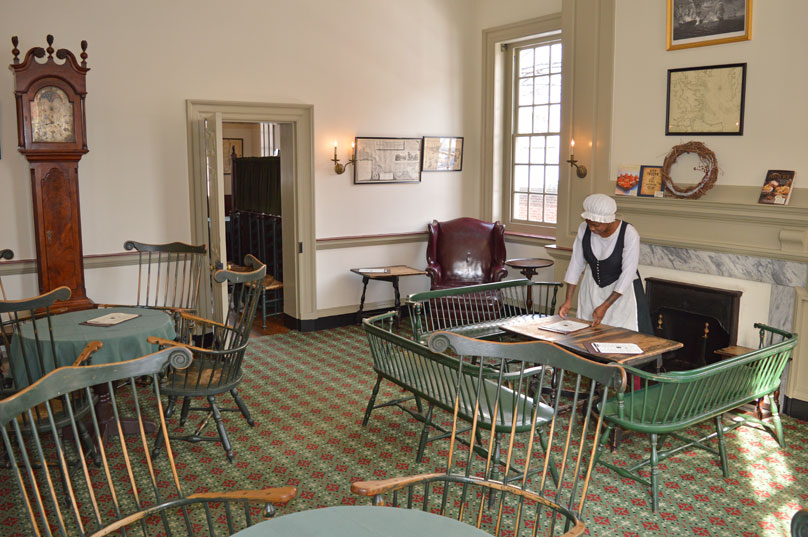
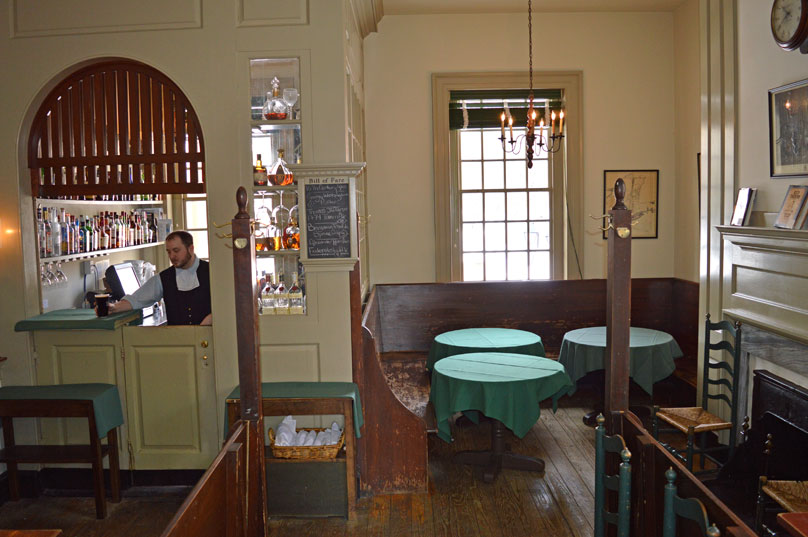
Across the hallway from the Subscription room is the Coffee Room. From the very beginning of the tavern’s history, a Coffee room was set aside where merchants could discuss ship movements (note the maps on the wall) over a cup of coffee or stronger drink. The room next to the Coffee Room is known simply as the Southwest Dining Room and is representative of the Tavern’s public dining spaces.
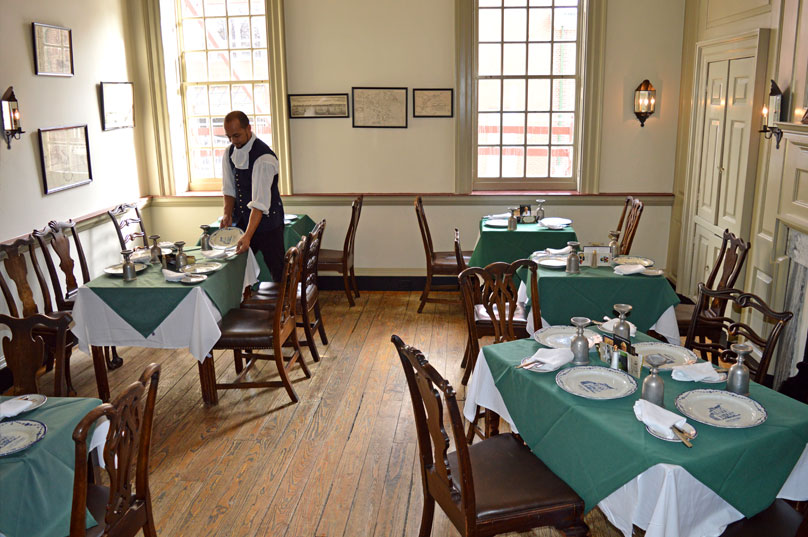
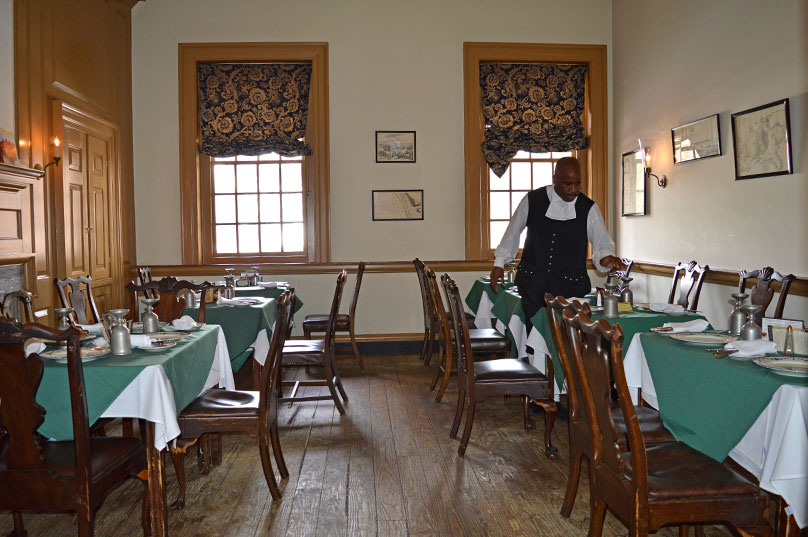
The stairs in the main hallway lead to the second floor. As you reach the top of the stairs, the Long Room is directly in front of you. The original Long Room was the scene of elegant balls and brilliant entertainments. It was in the Long Room that Congress held the first Fourth of July celebration in 1777.
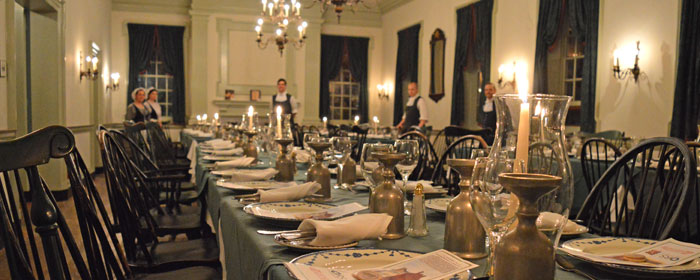
Adjoining the Long Room are two private dining rooms. These rooms would have accommodated clubs or groups desiring privacy. To your left (as you stand at the top of the stairs) is the Cincinnati Room, named in honor of the Pennsylvania chapter for the Society of the Cincinnati, which helped refurnish this room. This organization is composed of direct descendants of the Revolutionary officers who founded the original Pennsylvania chapter at the City Tavern in 1783.
The room to your right is called the Charter Room in honor of the subscribers to the constitution of the original City Tavern and, also in honor of the members of the National Home Fashions League who contributed toward furnishing the present City Tavern.
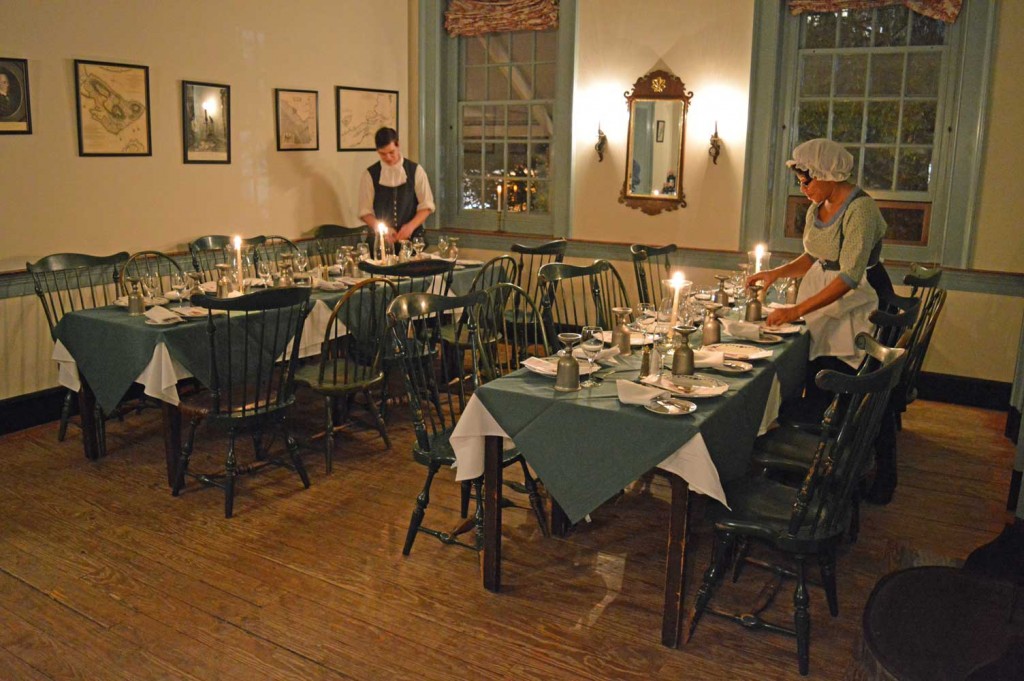
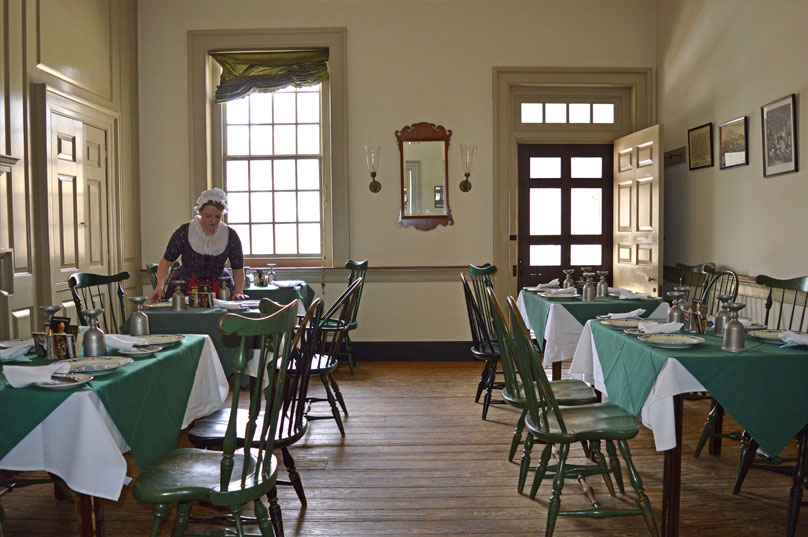
In 1994, the cellar area was opened to the public for dining. The adaptation of the City Tavern cellar provides insight into historical aspects of food storage, preparation, and service. From 1773-1848, the cellar served the vital purpose of work and storage areas. Fresh foodstuffs would be delivered to the Second Street Entrance. At the rear of the building, casks, barrels, and boxes were loaded into the cellar up throughout the cobblestone alley. There the cook-staff had access to water pumps on the public street. This area also served for dish-washing. The back cellar room was used for the long-term storage of bulk foodstuffs such as barrels and casks for flour. The larger room located on the southeast corner was probably used as a storeroom for prepared foods like pickled meat and preserved fruits. From the kitchen on the northeast corner, food was prepared and distributed for service. The cellar interpretation provides visitors with insights into the work so essential to the tavern’s success and shows the relationship to the areas above.
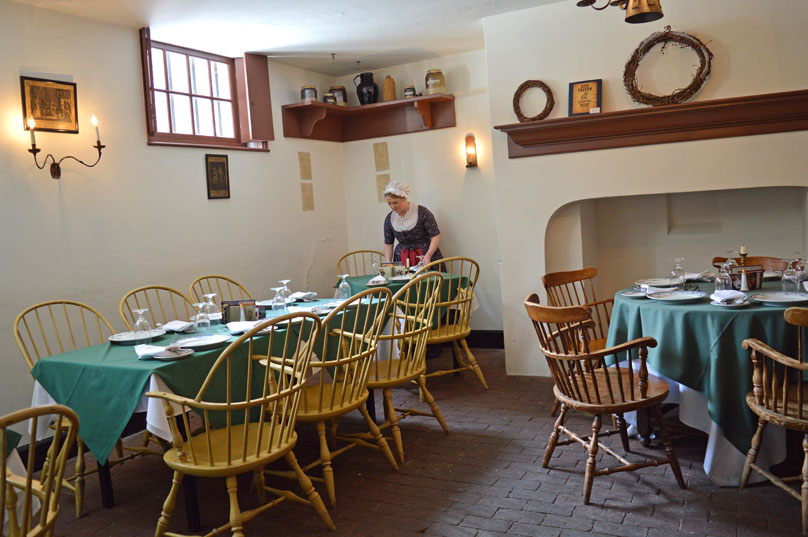
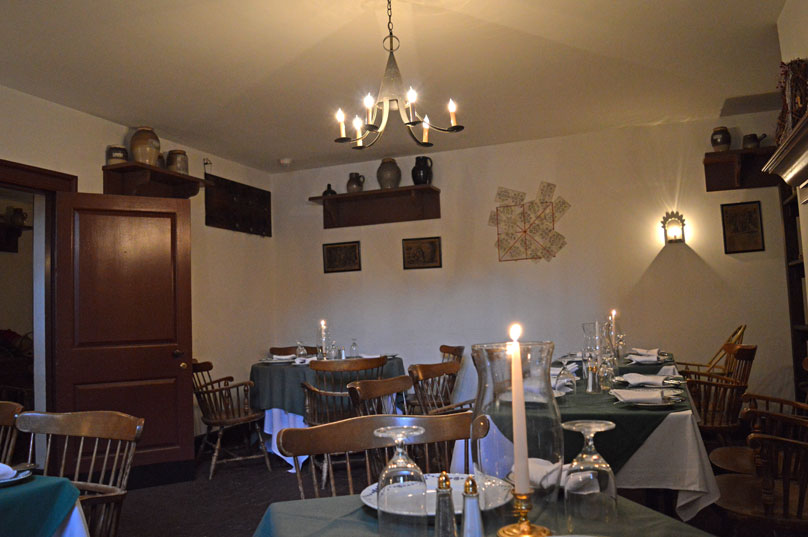
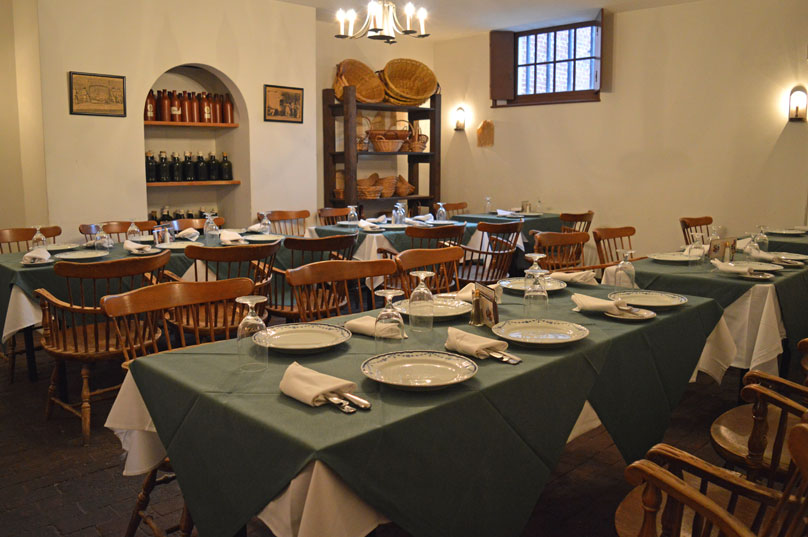
In 1975, after painstaking research, the National Park Service rebuilt the City Tavern. Today, the tavern appears essentially as it did two hundred years ago, even down to the front awning which shielded the tavern from the summer sun.
The City Tavern has been rebuilt so that you may enjoy a “taste” of the past and share the atmosphere of gentility and food cheer enjoyed by our nation’s founders. Both the National Park Service and Concepts by Staib, Ltd, the tavern’s operator, have made every effort to faithfully recreate the tavern as it operated during the American Revolution. It is our hope that, should John Adams return, he would still think of the tavern as “the most genteel tavern in America.”
When John Adams arrived in Philadelphia in August of 1774, to attend the First Continental Congress, he was greeted by leading citizens and immediately taken to the tavern he would call “the most genteel tavern in America.” The tavern Adams referred to, City Tavern was not yet a year old and was already caught in momentous events. A few months earlier, Paul Revere had ridden up to the tavern with the news of the closing of the port of Boston. Now, some of the most influential men in the colonies gathered in Philadelphia to decide a common response to this and other “intolerable acts.” For the next decade, the City Tavern would be a familiar sight to the leading figures of the American Revolution.
The tavern was built “for the convenience and credit of the city” by a group of eminent Philadelphians who felt that their hometown deserved a fine tavern which reflected its status as the largest, most cosmopolitan city in British North America. When the tavern was completed in 1773, it was one of the most elegant buildings in the city. Situated on Second Street, a main thoroughfare, the City Tavern was constructed in the latest architectural style and stood three stories high. Inside, it “boasted” of several large club rooms, two of which thrown into one make a spacious room of nearly fifty feet in length, for public entertainment. There were “several commodious lodging rooms, two large kitchens, and every other convenience for the purpose.” In addition, there was a Bar and also a Coffee Room, which was supplied with British and American newspapers and magazines.
The new tavern immediately became a social and economic center for the city. The club rooms hosted various benevolent and social organizations, including the St. George’s Society, the Friendly Sons of St. Patrick and the Jockey Club. The elegant Long Room was the setting for gala entertainment and balls. Downstairs, in the Bar and the Coffee Room, important business affairs were conducted by principal merchants of the city.
In 1774, as the breech with Great Britain widened, politics were the dominant topic of conversation at the City Tavern. In May, leading citizens held a meeting in the Long Room to shape Pennsylvania’s response to the “intolerable acts.” Three months later, as the delegates to the First Continental Congress began to arrive; the tavern was thrust center stage in the dispute with England.
From that time until the close of the century the City Tavern knew the patronage of the great and near-great of the American Revolution. It became the practice of the members of the Second Continental Congress to dine together each Saturday at the tavern. Eight of the delegates, Randolph, Lee, Washington, Harrison of Virginia, Alsop of New York, Chase of Maryland, and Rodney and Read of Delaware chose to form a “table” and dine there daily. No doubt, matters of momentous importance were discussed and decided over a glass of Madeira and steaming roast of venison.
The war years brought change and turmoil to the City Tavern. There was grand entertainment, such as the Continental Congress’s first Fourth of July celebration in 1777, but there were also melancholy events, including the funeral of General Hugh Mercer of Virginia. Daniel Smith, the first manager of the tavern, and host to the Continental Congress showed himself to be a Loyalist when the British Army captured Philadelphia in the Fall of 1777. When his protectors left in June of 1778, “little Smith” as he was known, went with them. Fortunately, a new manager, Gifford Dalley, was found in time to host a gala Independence Day celebration to mark the city’s liberation. After the war, the Tavern settled into a more sedate existence which was not interrupted until the opening of the Constitutional Convention in 1787. Once again, these leaders enjoyed the hospitality of the City Tavern. It was fitting that the adjournment of the convention in September, delegates gathered for one final dinner at the City Tavern.
In the 1790’s, the City Tavern began to lose its place of prominence to newly constructed “hotels.” For the next half century, it underwent a number of changes, serving primarily as a merchant’s exchange until 1834. In 1854 it was demolished to make way for new brownstone stores. A newspaper of the time noted the passing of the tavern, and remarked that in a generation or two, “The City Tavern will not be remembered except by some curious delver into the past.”
DINING CUSTOMS
The food which was served at the original City Tavern was not different from that of the present day. Although preparation time could be excruciatingly long, and primitive presentation methods limited the varieties of food available, many of the dishes offered then would be instantly recognized today. It is in dining customs that the 18th century differs most from our own.
Our ancestors ate their large meal considerably earlier than we do. Theirs was an age before long distance commuting; business was conducted early in the evening, with the main meal midway through the afternoon. The day began with breakfast and was concluded with a simple supper in the evening. In public establishments like the City Tavern, however, tea, coffee, soup, ice cream, and liquor were available at the bar at all times. As outlined in cookbooks of the period, the dinner meal generally had two courses, each of which combined meat, fish, meat and fruit pies, poultry, puddings, vegetables, and “relishes” (jellies or aspics, preserves, salads, and pickled food and so on). Of course the quality of food would vary according to the diners and the occasion. The various dishes for each course were spread upon the table in a precise manner, and diners choose from among the offerings, taking small portions from each.
As the century progressed, there is evidence that some Americans preferred to serve all, or nearly all, the meat dishes in the first course. Often, after the second course, the tablecloth was removed and fruit, cheese, and wine were served. At this time the ladies would withdraw, lest they be offended by the chance of a vulgar remark cause by the free flow of wine.
Perhaps, the most notable difference in dining customs between the 18th century and the present day is that, at least for the well-to-do, dining tended to be an experience rather than just a meal. It was in providing this experience that the City Tavern excelled.
An 18th century tavern was much more than a place to quench one’s thirst. In towns and cities where there were no office buildings, banks, stock exchanges, or convention centers, and where most men worked in their homes or in small offices, taverns served all these functions. Food and drink were, of course, served, but taverns were also the cities’ central meeting places. Stock and ship cargoes were bought and sold, new companies organized, notices posted, and newspapers from home and abroad pursued, all at the local tavern.
Social functions were equally important. Taverns hosted dinners for fraternal societies, meetings of political friends and foes, gatherings of local military companies, dances, musical concerts, and all sorts of other entertainments. News from afar reached taverns more quickly than it did the newspapers, another reason for their continued popularity.
There was an apparent distinction throughout most of the eighteen century between coffee houses, where food, drink, and meetings were of prime importance, and inns, where out-of-town visitors (or “strangers,” as they were known) might lodge. Taverns served both of these functions, making them important places for both local residents and visitors.
